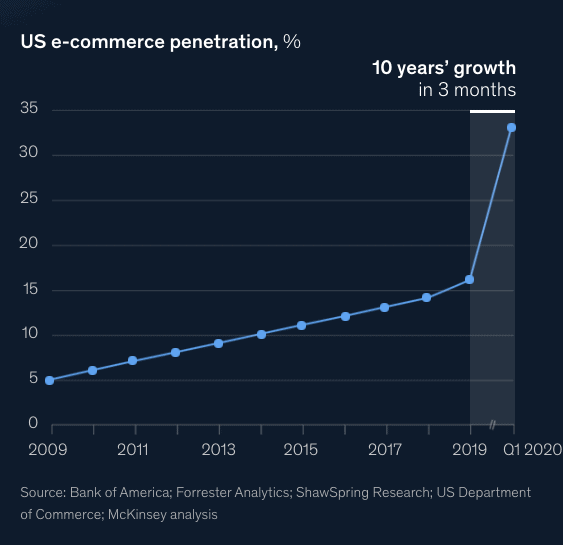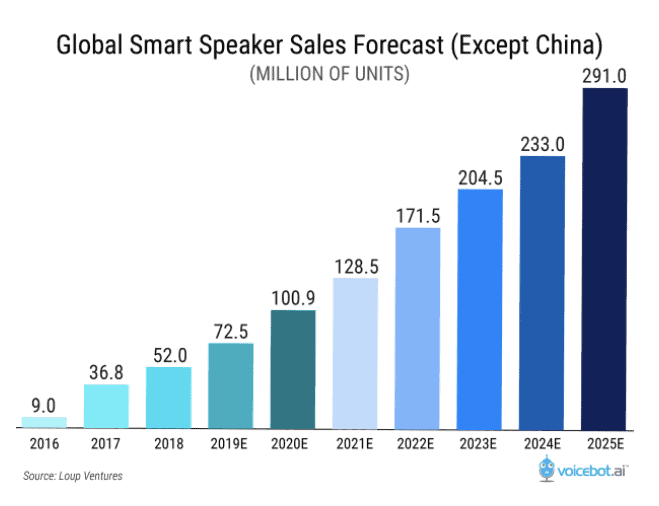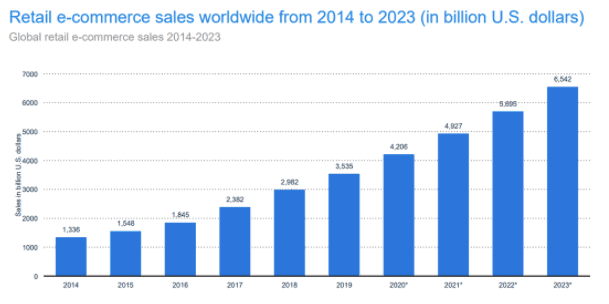2020 marks the start of a new decade. By the end of 2019, global e-commerce sales had reached $3.5 trillion and 14% of the total global retail market. It is predicted that, by the end of 2020, e-commerce sales will reach $4.2 trillion and continue to rise each year.
Undoubtedly, new technology and especially the outbreak of Covid-19 further accelerated this trend of moving commerce online. According to a recent Mckinsey report, around 10 year’s worth of US e-commerce penetration growth happened in only 3 month.

The trend has been long time coming but the acceleration has surprised many. The pandemic would have far-reaching impact on e-commerce and consumer shopping habit in the decade to come. Therefore, it is critical for business owners to adjusting its operations and keeping an eye on the new e-commerce trends of the future.
In this article, we are going to share 6 top e-commerce trends in the second half of 2020 to help you keep on track and grow your business. We want to note that none of those are specifically related to Covid. We may share other interesting trends that emerged because of the pandemic in another article.
1. AR and VR Integration will become a hit
One of the biggest differences between retail stores and e-commerce shops is that customers CANNOT feel or try the product before they purchase it. For example, except for price and size, customers care if they can have thorough information before they take out their credit card.
For example, they want to buy a top and a pair of pants but don’t know if they match, or someone would like to buy an oven but not sure if the color looks good in the kitchen. It has been an unbreakable challenge for e-commerce until there are AR (Augmented reality) and VR (Visual Reality) integration. These technologies show you seamless product details as if they are in the real world.
The applications of AR or VR are not massive yet, so far only big corporations have the resource to include such high technology. For instance, IKEA’s Place, an AR app that allows iPhone users to set IKEA furniture in their place, so that they can have a feeling of how it looks and if it fits without hassle. Thanks to this app, IKEA successfully reduced the return rate and attracted 2.3 billion website visitors in 2017 alone.
While IKEA brings virtual to the real world, eBay collaborates with Myer to create its first VR store for its customers in Australia. With a “shoptical” (a pair of VR glasses), customers can shop all the Myer products online, and lock their eyes to access more details about a specific product, and even more, add it to the shopping cart.
Reference:
- https://ecommercegermany.com/blog/ar-and-vr-in-e-commerce-a-tale-of-two-technologies
- https://www.ebayinc.com/stories/news/ebay-australia-helps-launch-the-worlds-first-virtual-reality-department-store-into-the-world-of-virtual-reality/
2. Smart assistants are changing our ways of shopping

Loop Ventures predicts that by 2025, 75% of U.S. households will have smart speakers, such as Google Assistant or Amazon Alexa, which means consumers are increasingly relying on voice assistants and searching by voice, whether it’s for weather forecasts or online purchases.
Imagine you are in the kitchen and you are out of milk or toilet paper, or you are getting ready for a friend’s wedding but realizing you need some accessories to match your outfit. All these can be done with the Smart Assistant’s simple, voice-activated (or voice-enabled) ordering process. No more trouble with browsing from page to page, and no need to enter payment and shipping information. One smart assistant will do!
“David Zimmerman, Director of eCommerce Solutions, Kensium, included ‘more involvement of voice-enabled solutions in the commerce space with Amazon Alexa and Google Home’ high on his list of 2020 trends to keep an eye on.”
3. Social commerce is booming
Social commerce, consumers buying directly on social media platforms, has been growing steadily in recent years. There has been many previous attempts with FB buy buttons and Pinterest buy buttons, but it has only really taken steam in the past few years with the booming popularities of online influencers.
As this trend continues to advance and grow into the second half of 2020, social giant Facebook continues to roll out shopping features such as Checkout on Instagram or the Facebook Shop, which allows social users to make purchases directly on the platforms.
Why is social commerce making such a huge impact?

One big appeal of social commerce is buying the product right at the context when it is discovered with other content. For example, seeing your favorite “Instagrammer” wearing a cute dress, and being able to directly buy it on the spot. Seeing a home furnishing video and buying some modern stools right on the spot. The seamless integration of browsing, checkout, payment is the appeal of social commerce.
4. Personalized product offerings

People have different preferences, like different colors, and prefer different designs. We live in an era where people pursue unique individual expression and identify. We simply don’t want the same thing as everyone else anymore. We want things to be unique, personalized, and special according to our needs.
Economically speaking, this is no simple task. Product pricing can be affordable when it is mass produced, and we all know how expensive a personal tailored suit cost vs one from H&M. But there have been brands experimenting with this trend. Take Nike by You as an example, customers can create a pair of sneakers online by choosing their style and color palettes. Some makers create customized special keyboards for programmers or gamers to improve their working or gaming efficiency. The key is finding a viable business model to strike the right balance of cost and offering enough “unique” varieties.
Some online stores use interactive content such as quizzes, games, and questionnaires to create customized products to meet customer needs. Native, for example, provides consumers with a unique fragrance through interactive quizzes, and because of its uniqueness, it helps increase consumer desire to place an order.
Oh, and these “one and only products” are usually sold for a higher price and don’t accept returns.
5. Let’s go eco-friendly!

“We only have one earth” is no longer a belief of the minority of people. According to statistics, around 87% of global consumers are willing to buy products from green brands. Eco-friendly product’s mission is to reduce waste, carbon footprint, help conserve resources like water and energy, and prevent contributions to air, water, and land pollution. Young people are especially in tune with sustainability initiative and missions.
Patagonia, one of the world’s most popular outdoor brands, has its mission to create the best product without harming the environment. They provide a lifetime warranty to prevent wastes and contribute 1% earth tax to support environmental organizations.
Some companies also use environmental awareness to launch creative marketing campaigns. Banish Skin Care, for instance, has abandoned the traditional way of packing products in foam and packaged them in branded socks to reduce packaging waste.
6. Dynamic Pricing strategy to help grow your profit
To keep up with e-commerce trends, it is crucial to pay attention to new technologies. A successful website would have experimented with a dozens of A/B tests on product layout, ranking, search, and many other aspects to move the needle on conversions. One trend that is worth paying attention to is dynamic pricing strategy, the idea of adjusting your product pricing strategy according to consumer demand on the fly, not only to avoid the Red Sea Competition but also to effectively increase revenue!
Yigit Kocak from Prisync shared, “To stand out in this highly-competitive environment, eCommerce companies need to monitor their competitors’ prices, analyze seasonal and historical demand, and react to these insights in nearly real-time. “
With a dynamic pricing strategy, the system can adjust to the “best price” according to a specific customer’s location and browning time. The “best price” means that the system will automatically display the price of the product that has the best chance of selling, as well as the maximum possible sales margin. To achieve an effective Dynamic pricing strategy, you need a system to monitor competitors’ prices, analyze the search data and trends in the marketplace for your merchandise, and sync these data back to the store in real-time. So while your customers are browning, you can entice them to complete payment by displaying the “best price” for their online purchase!
This isn’t necessary a brand new idea, as many merchants selling on Amazon have utilized “dynamic pricing” technology to adjust their product prices in real time in order to stay competitive on the marketplace. To achieve the same thing on standalone brands are much more challenging as competitors and things to track are more fragmented. Nonetheless, a simple place to start experimenting is running A/B tests on your product prices and find a sweet spot with your customers that maximize your overall profit!
These are 6 top e-commerce trends Kiwi Sizing provides for you, that you can think about as you continue to optimize your consumer experience for the rest of 2020. Hope those can be good food for thought for more ideas!
To reduce the return rate after a successful sale, we also recommend that you use Kiwi Sizing AI Size Recommender as a size chart tool. It will recommend the most suitable size of products for customers to reduce return rate, help you decrease the cost of the return, and to create a positive cycle of your e-commerce business.
- Official Website:https://www.kiwisizing.com/
- YouTube Tutorial:https://www.youtube.com/channel/UCQpP0NIIALWyMIa6NrFH3dw
- Demo Website:https://demo.kiwisizing.com/


